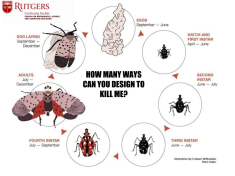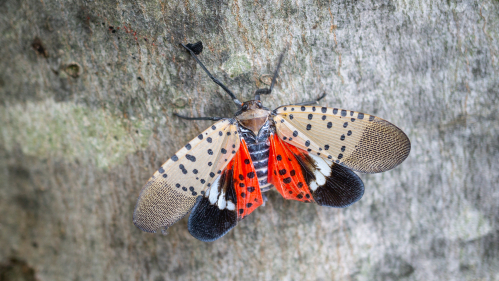Rutgers University is enlisting the state’s K-12 teachers and students in a Spotted Lanternfly Eradication Unit through a program designed to teach how to trap and kill the invasive East Asia insect that imperils the Garden State’s crops.
The Rutgers Center for Mathematics, Science and Computer Education (CMSCE) has created a four-hour, practical-experience workshop curriculum to be held at three wineries, which are particularly vulnerable to the lanternfly. Sessions will also be held at Rutgers University-New Brunswick and virtually. The workshops will begin just prior to the lanternfly hatching season in early May.
“The Spotted Lanternfly is an invasive species that despite quarantine efforts has spread to 11 states after being introduced in Pennsylvania only eight years ago,” says Eddie Cohen, CMSCE assistant director. “It is important to eradicate the insect because it poses a great threat to U.S. agriculture. The economic impact could reach hundreds of millions of dollars and be especially harmful to those who farm grapes, hops and apples, as well as those in the hardwood industry."

As the lanternfly is a relatively new invasive species, there are few high-quality workshops for those who want to stop the spread of the lanternfly and reduce the damage, Cohen said. CMSCE is providing lessons on how to use STEAM in creating differentiated units that any educator can implement easily in the classroom. Knowing that the grapevine is one of the most vulnerable economic crops in N.J., CMSCE has partnered with local orchards and wineries to share lessons with educators on the farm.
Each training session will offer four Continuing Education Credits and will provide teachers with the educational materials they need to teach the subject in their classrooms, including lesson plans and a review of the building materials available, and will enable them to design and build their own lanternfly traps, as well as teach others how to do so.
“We invite participation from all elementary and high school teachers, informal educators and anyone else who wants to remove lanternflies from our environment,” said David Shernoff, CMSCE director. “Participants will leave with the design-thinking understanding and knowledge to build more solutions tailored to their classroom environments and communities.”
Lanternflies first arrived in Pennsylvania in 2014. The Spotted Lanternfly was first confirmed in New Jersey in 2018.
The Spotted Lanternfly uses its piercing-sucking mouthpart to feed on sap from over 70 different plant species. It has a strong preference for economically important plants, and the feeding damage significantly stresses the plants, which can lead to decreased health and potentially death.
The workshop dates and sites include:
- April 29 at Terhune Orchards of Princeton
- May 12 at Beneduce Vineyards of Alexandria
- June 7 and 8, Virtual Session, both dates required for course completion, 4-6 p.m.
- June 9 at the 134-year-old Tomasello Winery in Hammonton
- July 19 and 20, Virtual Session, 4-6 p.m.
- July 21 at Rutgers New Brunswick, 10-2 p.m.
CMSCE staff has designed the coursework to help educators with problem-based learning, design thinking, engineering and a blended-learning format that align with the Next Generation Science Standards, Common Core Math, and Language Arts, while including information on the new N.J. Climate Change Standards to be implemented in 2022.
The Penn State Extension says as few as 25-30 lanternflies can kill a grape vine, and many Pennsylvania crops have already been lost to the invasive species.



